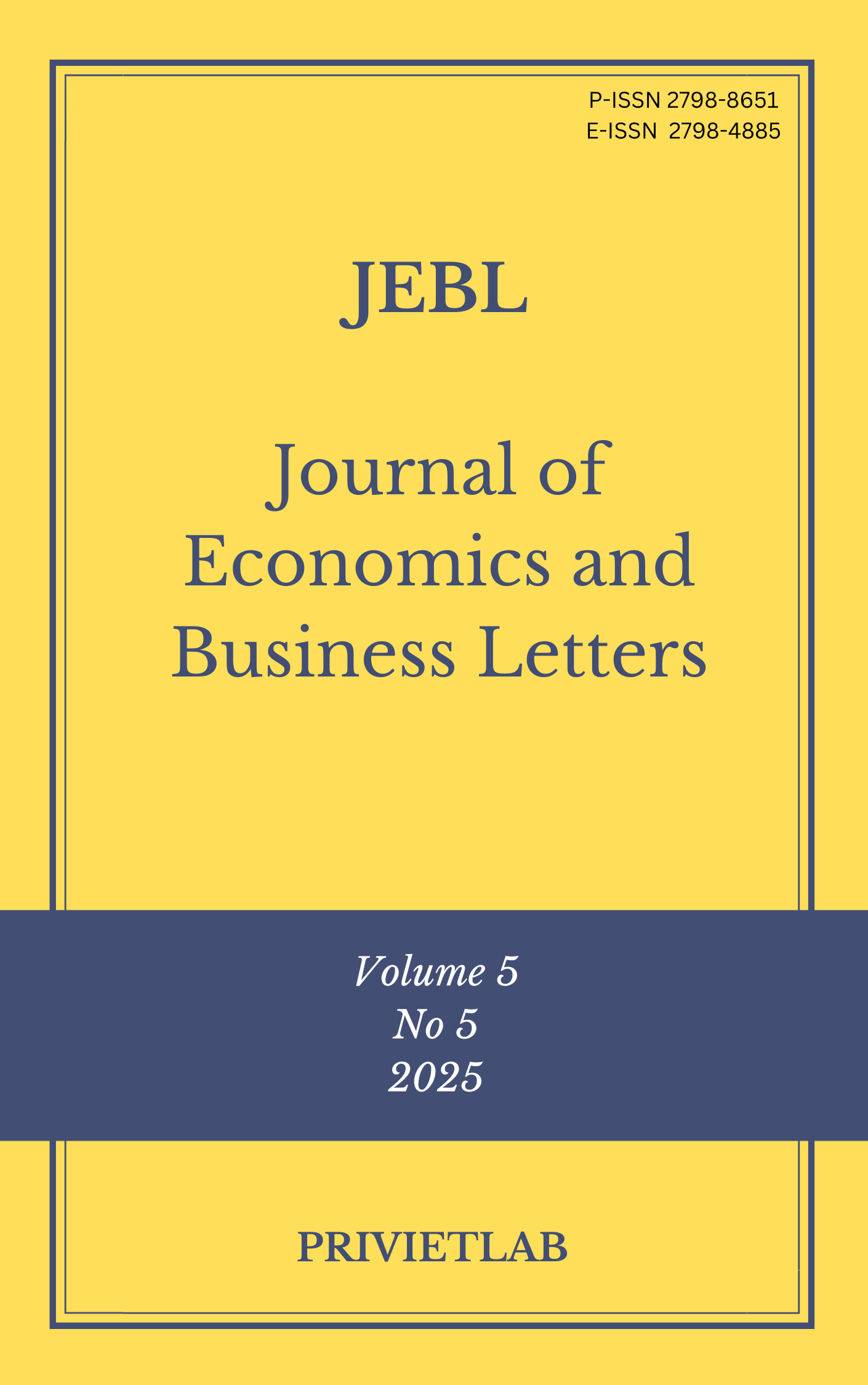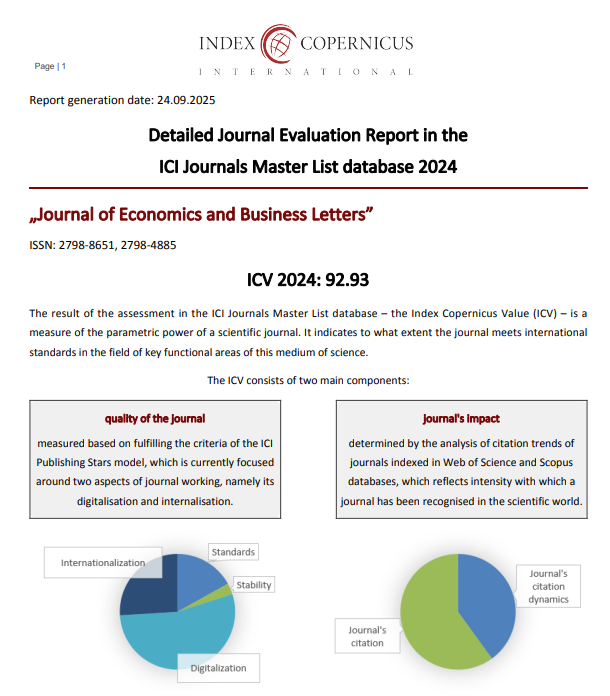FDI inflows and domestic interest rate nexus in Nigeria: A new look at the mundell-flemming hypothesis
DOI:
https://doi.org/10.55942/jebl.v5i5.519Keywords:
FDI inflows, exchange rate, real interest rate, ARDLAbstract
The relevance of FDI to an economy has led to an avalanche of studies investigating its link with other macroeconomic variables. One such variable that has been discussed extensively in the literature is the domestic interest rate. The link between FDI inflows and interest has been emphasized by the Mundell-Flemming framework, and in recent times, some scholars have contended that FDI inflows exert a downward influence on domestic interest rates. This study seeks to provide empirical evidence for the latter claim by examining the impact of FDI inflows on interest rates in Nigeria. The study used an annual series ranging from 1981-2022 to and under the ARDL framework. The findings reveal that in both the short and long runs, FDI inflows have a negative and significant impact on the real interest rate. This outcome has implications for the implementation of monetary policy in Nigeria. Although a fall in the interest rate is necessary, it could adversely impact the inflation-targeting objective of the monetary authorities. Therefore, the choice of allowing much inflow of FDI into the country should be weighed against the inflationary impact they portend.
References
Adrian, T. (2018). Policy responses to capital flows. Speech delivered at LIII Meeting of Governors of Latin America, Spain and the Philippines at the IMF-World Bank Annual Meetings in Bali, Indonesia, October 11. Retrieved from https://www.imf.org/en/News/Articles/2018/11/15/sp101118-policy-responses-to-capitalflows.
Adu, B. E. & Ntim, A. L. (2014). Causality analysis of foreign direct investment, exchange rate and interest rate volatility in Ghana. Journal of Economics and Sustainable Development, 5(9), 17-25. https://core.ac.uk/download/pdf/234646389.pdf
Ali, S. & Nazar, R. (2017). Impact of foreign capital inflows and money supply on exchange rate: A case study of Pakistan. Review of Economics and Development Studies, 3(1), 83-90. https://www.researchgate.net/publication/322633592_Impact_of_Foreign_Capital_Inflows_and_Money_Supply_on_Exchange_Rate_A_Case_Study_of_Pakistan
Benson, E., Eya, C. I. & Yunusa, A. (2019). .Effect of exchange and interest rates on foreign direct investment in Nigeria. International Journal of Contemporary Research and Review, 10(7), 72-85. https://doi.org/10.15520/ijcrr.v10i07.717.
Elumalue, G. I., Obi, K. C., & Ezi, C. T. (2025). The moderating effect of interest rate on exchange rate volatility and foreign direct investment: An insight in some sub-Saharan African countries. International Journal of Advanced Economics, 7(3). https://doi.org/10.51594/ijae.v7i3.1821.
Hymer, S. H. (1976). The international operations of national firms: A study of direct foreign investment. PhD Dissertation Published posthumously. Cambridge, Mass, Mass: The MIT Press.
Idoko. I. A., Eche, E.& kpeyol, K. (2020). An assessment of the impact of interest rates deregulation on economic growth in Nigeria. International Journal of Economics, 14(2), 143-156. https://www.econbiz.de/Record/an-assessment-of-the-impact-of-interest-rates-deregulation-on-economic-growth-in-nigeria-idoko-itodo-ahmed/10009684997
Ikhinde, S, I. & Alawode, A.A (2001). Financial sector reforms, micro economic instability and the order of economic liberation: The evidence from Nigeria. African Economic Research Paper No 112. https://publication.aercafricalibrary.org/123456789/445
Isiaka, N. A., Osifalujo, B. B. & Taiwo, O. K. (2022). Interest rate and foreign direct investment in Sub-Sahara African countries: The comparison between asymmetric and symmetric effects (ARDL and NARDL approach). International Journal of Economics, Social Science, Entrepreneurship and Technology, 1(3), 186-200. http://journal.sinergicendikia.com/index.php/ijeset/article/view/193
Karahan, O. & Bayır, M. (2022). The effects of monetary policies on foreign direct investment inflows in emerging economies: Some policy implications for post‑COVID‑19
Karahan and Bayır Future Business Journal, 8(1), 39. Retrieved from: https://doi.org/10.1186/s43093-022-00152-6.
Karau, J., & Ng’ang’a, P. (2019). Effects of macroeconomic factors on FDI in Kenya. European Journal of Business and Management, 11(3), 55-62. https://doi.org/10.7176/EJBM
Karimo, T. M. (2020). Impact of interest rate differential and exchange rate movement on the dynamics of Nigeria’s international private capital flows. CBN Journal of Applied Statistics, 11(2), 29-63. https://dc.cbn.gov.ng/jas/vol12/iss1/7
Ljubaj, L., Martinis, A. & Mrkalj, M. (2010). Capital inflows and efficiency of sterilization: Estimation of sterilization and offset coefficients. Croatian National Bank Working paper 24. https://ideas.repec.org/p/hnb/wpaper/24.html
Kiliçarslan, Z. (2018). The relationship between exchange rate volatility and foreign direct investment in Turkey: Toda and Yamamoto causality analysis. International Journal of Economics and Financial Issues, 8(4), 61-67. http: www.econjournals.com
Nguyen, V. C. (2023). Monetary policy and foreign direct investment: Empirical evidence. Economies, 11,234. https://doi.org/10.3390/economies11090234
Odionye, J. C., Ojiaku, E. U & Uba, C. N. (2023). Impact of interest rate differential, exchange rate changes and political stability on foreign capital inflow in Nigeria: Discrete threshold regression model. Cogent Economics and Finance, 11(1), 2023. https://doi.org/10.1080/23322039.2023.2203590
Onakoya, A. B. & Agunbiade, O. A. (2020) Oil sector performance and Nigerian macroeconomic variables. International Journal of Economics, Management and Accounting, 28(1), 35-62. https://doi.org/10.31436/ijema.v28i1.700
Salim, A. D. (2020). Monetary Policy and its role in attracting foreign direct investment: A study in the Iraqi economy for the period (2004-2018). Journal of Business and Management Studies, 4(4), 133-148. https://doi.org/10.32996/jbms.2022.4.4.13
Tiberto, B. P. & de Mendonça, H. F. (2023). Effects of sustainable monetary and fiscal policy on FDI inflows to emerging markets and developing economies. Banco Central do Brazil Working Paper Series 575. https://www.bcb.gov.br/pec/wps/ingl/wps575.pdf
Vidhya, K. & Ahamed, S. B. (2019).The relationship of interest rate, exchange rate, GDP and FDI with respect to Chinese economy. International Journal of Innovative Technology and Exploring Engineering, 8(11), 273-277. https://doi.org/10.35940/ijitee.K1042.09811S219.
Wawrosz, P. & Traksel, S. (2023). Negative interest rates and its impact on GDP, FDI and banks’ financial performance: The cases of Switzerland and Sweden. International Journal of Financial Studies, 11, 69. Retrieved from https://doi.org/10.3390/ijfs11020069.
Downloads
Published
How to Cite
Issue
Section
License
Copyright (c) 2025 Hycenth Richard Oguejiofoalu Ogwuru, Innocent Chile Nzeh, Austine Chijioke Emele, Justice Ndubueze Onyenze, Zion Stephen Ekainsai

This work is licensed under a Creative Commons Attribution 4.0 International License.
















